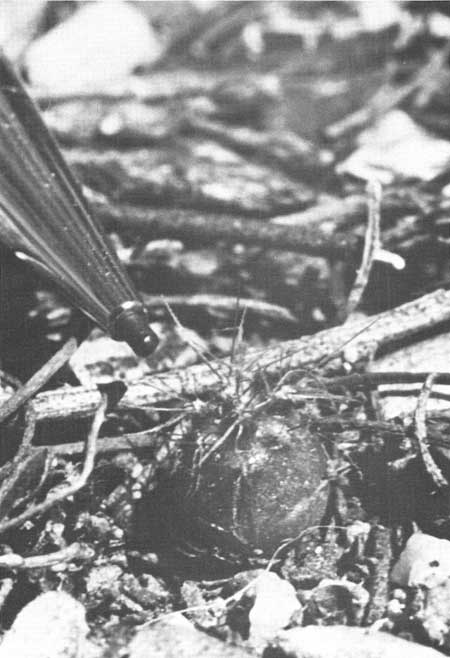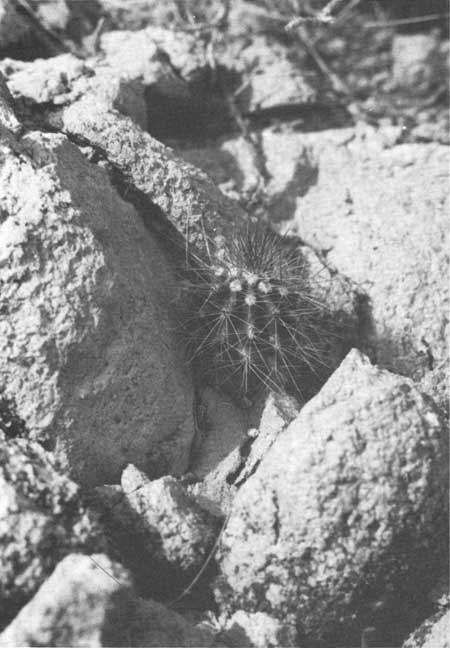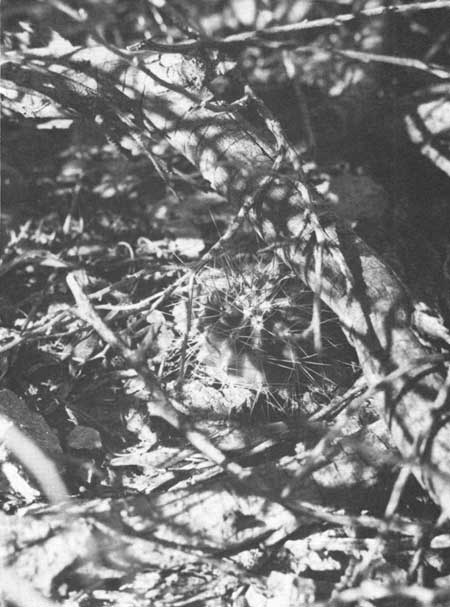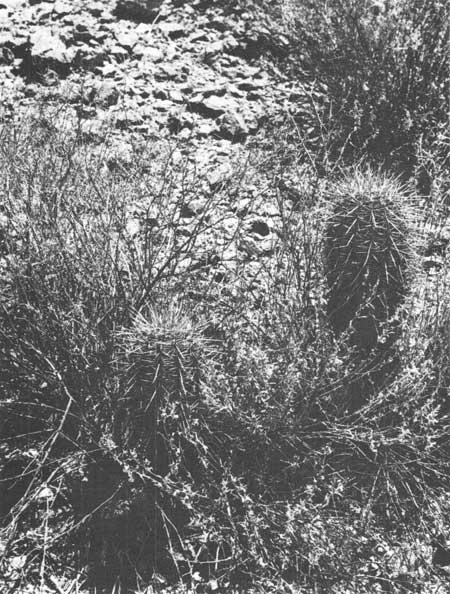|
SAGUARO
Ecology of the Saguaro: II NPS Scientific Monograph No. 8 |

|
CHAPTER 4:
ESTABLISHMENT AND SURVIVAL
The seeds which reach the ground quickly germinate in the baking soil, and the tiny capsules of acid water stored in the plump spineless hypocotyl constitute a most attractive morsel for the thirsty and hungry animals, and not one seedling in a million survives the first year in consequence.—D. T. MacDougal, "Across Papagueria," 1908b:98.
Of the many thousands of saguaro seedlings that emerge each summer, all but a few are doomed to destruction within the year. Most of the succulent, weakly rooted seedlings are eaten or uprooted by foraging animals, or they die from drought or winter cold. The few surviving individuals are usually concealed beneath protecting shrubs, fallen limbs, or among rocks. There they may be further hidden by detritus.
The average life expectancy of a newly sprouted saguaro seedling is less than 6 weeks. Emerging within a few days after the end of the prolonged drought of the arid fore-summer when other sources of moisture are scarce, the succulent seedling is prey to an abundance of insects, rodents, and even to destruction by foraging birds.
The relatively few survivors proceed toward establishment, which is the process of stabilization that takes place from germination through seedling development into juvenile saguaro status (Figs. 24-26). The juvenile is a well-rooted and self-supporting young plant in which a certain continuance is assured. The seedling saguaro is the emerged young plant—after rupture of the seed coat at germination—that remains relatively vulnerable without benefit of the self-sustaining features that characterize later life as an established juvenile plant (Fig. 24A). For the saguaro establishment is ordinarily reached at an age of 12-14 months (Fig. 24B). Thus, the tenuous process of establishment is accomplished by a seedling saguaro during its first biological year of life, a period that may exceed a calendar year by 1 or 2 months.

|
| Fig. 24A. A newly sprouted saguaro seedling in the Cactus Forest at Saguaro National Monument (east). In this habitat the average life expectancy of such naturally growing seedlings of a few millimeters in size is less than 6 weeks. Most of the tiny succulent seedlings die from lack of moisture or are destroyed by a variety of insects, rodents, and foraging birds during the first summer and fall of life. Photographed by Harold T. Coss, 23 July 1970. |

|
| Fig. 24B. Yearling saguaro, Cactus Forest, Saguaro National Monument (east). Barely 5 mm (0.25 inch) tall, the established plant has survived the numerous hazards of the first year of life. With the resumption of growth during the second summer of life, the seedling enters the globose juvenile stage of development. Photographed by Harold T. Coss, 23 July 1970. |

|
| Fig. 25A. Juvenile saguaro, globose stage, height approximately 2.5 cm (1 inch), in rock outcrop. Rocks concentrate and prolong availability of soil moisture. Re-radiation during cold winter nights moderates the intensity and duration of low temperatures. Such environmental modification and concealment that is found in rocky habitats markedly enhance probabilities of both the seedling's establishment and its following survival during the vulnerable juvenile years. Photographed 13 Feb 1970. |

|
| Fig. 25B. Juvenile saguaro, globose stage, height approximately 2.5 cm (1 inch), beneath the crown of a foothill paloverde tree (Cercidium microphyllum) in nonrocky habitat. Pebbles and detritus provide concealment and protection from destruction by animals. Shade from overhanging crown of trees and shrubs prolongs availability of soil moisture. Overhanging canopy reduces nocturnal heat loss and provides protection from freezing. As in rocky habitats (see Fig. 25A), the concealment and the modification of limiting factors favor both the establishment and the following survival of young saguaros. Photographed 14 Dec. 1969. |

|
| Fig. 26A. Juvenile saguaro, columnar stage, ht 50 cm (20 inches), in rocky habitat. Transition from globose to columnar "club" form occurs when the plant reaches a height of 5-10 cm (2-4 inches). Nocturnal re-radiation from the adjacent rock face aids winter survival, throughout the life of the plant by protecting it from lethal subfreezing temperatures. Photographed 22 Jan. 1971. |

|
| Fig. 26B. Juvenile saguaro, columnar stage, ht 50 cm (20 inches), in a low shrub (triangle bursage [Ambrosia deltoidea]). The young saguaro has outgrown the protection of its "nurse-plant." The projecting cold-sensitive tip of the plant now radiates directly to the night sky and is fully exposed to extremes of winter cold. Freeze-caused damage to the apex—and often death—is a common occurrence in the Tucson vicinity and elsewhere in the colder portions of the saguaro's distribution. Photographed 17 June 1974. |
| <<< Previous | <<< Contents >>> | Next >>> |
chap4.htm
Last Updated: 21-Oct-2005